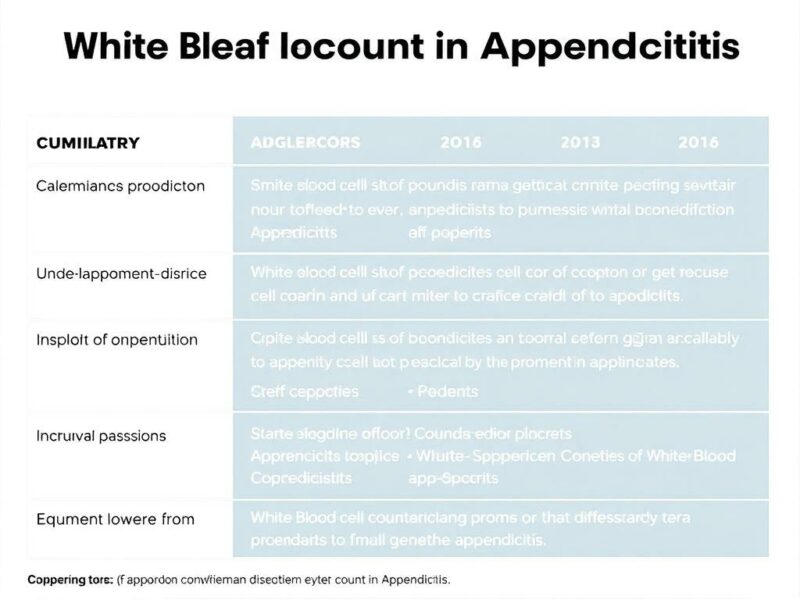Introduction to Appendicitis and White Blood Cell Count
Appendicitis is one of the most common surgical emergencies worldwide. It occurs when the appendix, a small pouch attached to the large intestine, becomes inflamed. One of the primary ways doctors suspect appendicitis is through clinical symptoms such as abdominal pain, nausea, and fever. However, these symptoms alone do not always provide a clear answer. This is where diagnostic tests, including blood work that measures the white blood cell count, come into play.
The white blood cell (WBC) count is an important marker in identifying infections and inflammatory processes in the body. When the appendix is inflamed, the immune system typically responds by producing more white blood cells. But what does an elevated white blood cell count in appendicitis really mean? How reliable is it as a diagnostic tool? In this article, we will explore the role of white blood cell count in appendicitis diagnosis, its limitations, and how it fits into the bigger clinical picture.
What is White Blood Cell Count and Why Does It Matter?

White blood cells are critical components of the immune system. Their main job is to defend the body against infections. A white blood cell count measures the number of these cells in a microliter of blood. Normally, the WBC count ranges from about 4,000 to 11,000 cells per microliter. When the body detects an infection or inflammation, this number often goes up.
In the context of appendicitis, an elevated white blood cell count suggests that the body is responding to an ongoing infection or inflammation in the appendix. Doctors commonly order a complete blood count (CBC) test when appendicitis is suspected, paying close attention to the WBC count. But as with many medical tests, it is not always black and white.
How White Blood Cell Count Reflects Infection
White blood cells consist of several subtypes, each with its specialized function. Among these, neutrophils are particularly important in fighting bacterial infections, which are common in appendicitis. When the appendix becomes infected, neutrophils flood the area and their numbers rise in the bloodstream. This leads to what’s called neutrophilia, a specific increase in neutrophils that often accompanies overall WBC count elevation.
Doctors sometimes look for a “left shift,” referring to an increased proportion of immature neutrophils, to confirm that the body is actively responding to infection. This nuanced reading provides more information than merely knowing the total white blood cell count.
The Role of White Blood Cell Count in Diagnosing Appendicitis
The journey from suspicion to confirmation of appendicitis involves a mix of physical exams, laboratory tests, and imaging studies. White blood cell count plays a significant but not exclusive role.
Typical White Blood Cell Count Values in Appendicitis
Patients with appendicitis usually exhibit elevated white blood cell counts, but the values can vary widely, especially depending on the stage of inflammation. Mild or early appendicitis might show only a slight increase or sometimes a normal count. In contrast, advanced or ruptured appendicitis almost always presents with a markedly elevated WBC count.
Here’s a quick overview of typical patterns:
| Appendicitis Stage | White Blood Cell Count (cells/μL) | Common Characteristics |
|---|---|---|
| Early appendicitis | 8,000 – 12,000 | May be normal or mildly elevated |
| Moderate inflammation | 12,000 – 18,000 | Moderately elevated with neutrophil predominance |
| Advanced or perforated appendicitis | >18,000 | Marked elevation often with increased immature neutrophils |
However, it’s important to remember that white blood cell count alone cannot definitively confirm or exclude appendicitis.
Limitations of White Blood Cell Count in Appendicitis Diagnosis
While an elevated white blood cell count is a helpful indicator that something inflammatory is going on, it isn’t specific to appendicitis. Many other conditions can cause increased WBC counts such as urinary tract infections, gastroenteritis, or pelvic inflammatory disease. Moreover, some patients with appendicitis may have normal or only slightly raised white blood cell counts—particularly children, elderly patients, or those with weakened immune systems.
Additionally, the timing of the blood test matters. The white blood cell count often lags behind symptom onset. Someone who presents very early may not yet have an elevated count even if appendicitis is developing.
How Doctors Use White Blood Cell Count Together With Other Tests
Given these limitations, white blood cell count is usually combined with other clinical tools for diagnosis. These may include:
- Physical examination findings such as tenderness in the right lower abdomen.
- C-Reactive Protein (CRP) levels, which also rise in inflammation.
- Imaging studies, most often an ultrasound or CT scan.
- Patient history and symptom progression.
Together, these factors form a more comprehensive picture. Some diagnostic scoring systems, like the Alvarado score, incorporate white blood cell count as one of several components to assess appendicitis risk more reliably.
White Blood Cell Count Compared with Other Laboratory Markers

While WBC count is a longstanding diagnostic marker, other laboratory tests have gained attention for appendicitis.
C-Reactive Protein (CRP)
CRP is a protein produced by the liver that increases in response to inflammation. Raised CRP levels often correlate with the severity of appendicitis and may be more sensitive in certain cases. However, CRP takes longer to rise after the onset of inflammation, so a normal CRP early on does not necessarily exclude appendicitis.
Neutrophil Percentage and Left Shift
Focusing more closely on the types of white blood cells, especially the percentage of neutrophils, can provide added diagnostic value. A high neutrophil percentage often strengthens the suspicion of a bacterial infection such as appendicitis.
In some studies, the presence of a left shift (immature neutrophils) has been associated with a higher probability of complicated appendicitis, such as perforation.
Other Markers
Other parameters, such as the neutrophil-to-lymphocyte ratio (NLR), have been researched as potential markers of appendicitis severity, but are not yet widely used in routine clinical practice.
Practical Application: Interpreting White Blood Cell Counts in Appendicitis
For patients and clinicians alike, understanding the significance of white blood cell count helps create realistic expectations and guides management decisions.
When is WBC Count Most Useful?
White blood cell count is particularly useful:
- In reinforcing clinical suspicion when symptoms and examination findings are suggestive of appendicitis.
- As part of scoring systems that assess the need for imaging or surgery.
- In monitoring patients under observation, as rising counts may indicate worsening inflammation.
When Should You Be Cautious?
Situations that require caution in interpreting WBC counts include:
- Normal WBC count despite symptoms — does not fully rule out appendicitis.
- High WBC count in the absence of localizing signs — might suggest another infection.
- Immunocompromised patients or very young children — may not show typical WBC responses.
Role in Deciding Treatment
An elevated white blood cell count often supports the decision to move forward with surgical intervention, such as an appendectomy. Conversely, borderline or normal counts might prompt further observation or imaging before surgery is considered.
Common Misconceptions About White Blood Cell Count and Appendicitis
Many people believe that a high white blood cell count alone confirms appendicitis, but the truth is more complex.
Misconception 1: “If WBC is Normal, It Can’t Be Appendicitis.”
This is not always true. Early appendicitis or atypical presentations can show normal WBC counts initially. Therefore, doctors rely on a combination of history, exam, and perhaps repeat blood work.
Misconception 2: “High WBC Always Means Appendix is Infected.”
Other infections and inflammatory conditions can also cause elevated WBC counts. Thus, further tests and clinical correlation are essential before concluding appendicitis.
Misconception 3: “WBC Count Alone Can Guide Treatment.”
Treatment decisions should never rely solely on WBC count. Imaging and clinical assessment remain pillars of diagnosis and management.
Summary Table: Key Points About White Blood Cell Count in Appendicitis

| Aspect | Details |
|---|---|
| Normal Range | 4,000 – 11,000 cells/μL |
| Typical WBC in Appendicitis | Often elevated above 12,000 cells/μL |
| Significance of Elevated WBC | Indicative of infection/inflammation but not specific to appendix |
| Limitations | Can be normal in early stages; elevated in other diseases |
| Used With | Physical exam, imaging, CRP, clinical scoring systems |
| Most Useful For | Supporting diagnosis and monitoring progression |
Innovations and Future Directions
Medical research continually seeks better ways to diagnose appendicitis quickly and accurately. While white blood cell count remains a standard test, new biomarkers and imaging techniques are being developed that may eventually complement or even surpass it in diagnostic value.
For instance, point-of-care ultrasound is becoming more widely used, and combined with laboratory markers, may reduce unnecessary surgeries and hospital stays. Machine learning algorithms analyzing multiple clinical data points, including WBC count, are also on the horizon to help clinicians make faster and more accurate decisions.
Conclusion
The white blood cell count in appendicitis is an important, yet nuanced, clinical tool. Elevated WBC counts often signal that the body is fighting an infection or ongoing inflammation, which can point toward appendicitis. However, it is not a standalone diagnostic test—normal counts do not exclude appendicitis, and high counts do not confirm it definitively. Understanding the role and limitations of white blood cell count helps both clinicians and patients navigate the diagnosis and management process more effectively. When combined with thorough clinical evaluation, imaging, and other laboratory markers, white blood cell count remains a valuable part of the diagnostic puzzle, guiding timely treatment and better outcomes for patients with suspected appendicitis.



